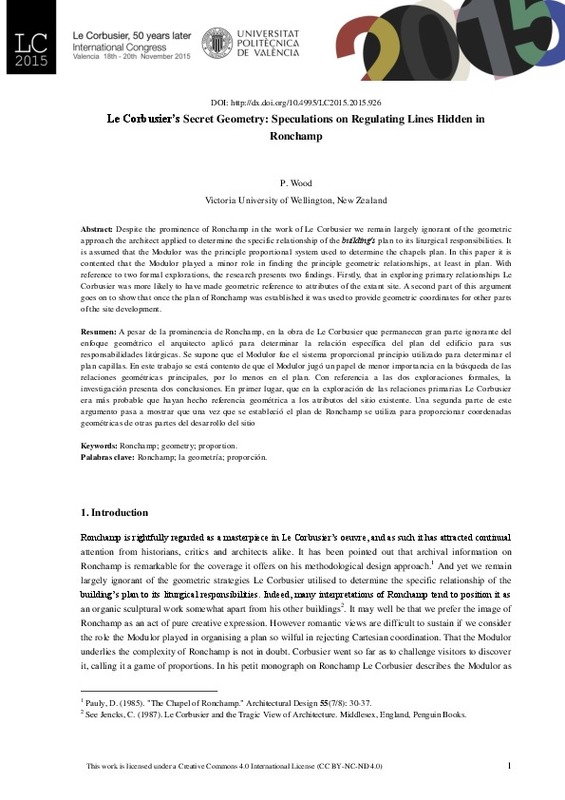JavaScript is disabled for your browser. Some features of this site may not work without it.
Buscar en RiuNet
Listar
Mi cuenta
Estadísticas
Ayuda RiuNet
Admin. UPV
Le Corbusier’s Secret Geometry: Speculations on Regulating Lines Hidden in Ronchamp
Mostrar el registro sencillo del ítem
Ficheros en el ítem
| dc.contributor.author | Wood, Peter
|
es_ES |
| dc.date.accessioned | 2017-09-18T09:58:23Z | |
| dc.date.available | 2017-09-18T09:58:23Z | |
| dc.date.issued | 2016-03-03 | |
| dc.identifier.isbn | 9788490483732 | |
| dc.identifier.uri | http://hdl.handle.net/10251/87417 | |
| dc.description.abstract | [EN] Despite the prominence of Ronchamp in the work of Le Corbusier we remain largely ignorant of the geometric approach the architect applied to determine the specific relationship of the building’s plan to its liturgical responsibilities. It is assumed that the Modulor was the principle proportional system used to determine the chapels plan. In this paper it is contented that the Modulor played a minor role in finding the principle geometric relationships, at least in plan. With reference to two formal explorations, the research presents two findings. Firstly, that in exploring primary relationships Le Corbusier was more likely to have made geometric reference to attributes of the extant site. A second part of this argument goes on to show that once the plan of Ronchamp was established it was used to provide geometric coordinates for other parts of the site development | es_ES |
| dc.description.abstract | [ES] A pesar de la prominencia de Ronchamp, en la obra de Le Corbusier que permanecen gran parte ignorante del enfoque geométrico el arquitecto aplicó para determinar la relación específica del plan del edificio para sus responsabilidades litúrgicas. Se supone que el Modulor fue el sistema proporcional principio utilizado para determinar el plan capillas. En este trabajo se está contento de que el Modulor jugó un papel de menor importancia en la búsqueda de las relaciones geométricas principales, por lo menos en el plan. Con referencia a las dos exploraciones formales, la investigación presenta dos conclusiones. En primer lugar, que en la exploración de las relaciones primarias Le Corbusier era más probable que hayan hecho referencia geométrica a los atributos del sitio existente. Una segunda parte de este argumento pasa a mostrar que una vez que se estableció el plan de Ronchamp se utiliza para proporcionar coordenadas geométricas de otras partes del desarrollo del sitio | es_ES |
| dc.format.extent | 16 | es_ES |
| dc.language | Inglés | es_ES |
| dc.publisher | Editorial Universitat Politècnica de València | es_ES |
| dc.relation.ispartof | LE CORBUSIER. 50 AÑOS DESPUÉS | es_ES |
| dc.rights | Reconocimiento - No comercial - Sin obra derivada (by-nc-nd) | es_ES |
| dc.subject | architecture | es_ES |
| dc.subject | le corbusier | es_ES |
| dc.subject | modern movement | es_ES |
| dc.title | Le Corbusier’s Secret Geometry: Speculations on Regulating Lines Hidden in Ronchamp | es_ES |
| dc.type | Capítulo de libro | es_ES |
| dc.type | Comunicación en congreso | es_ES |
| dc.identifier.doi | 10.4995/LC2015.2015.926 | |
| dc.rights.accessRights | Abierto | es_ES |
| dc.description.bibliographicCitation | Wood, P. (2016). Le Corbusier’s Secret Geometry: Speculations on Regulating Lines Hidden in Ronchamp. En LE CORBUSIER. 50 AÑOS DESPUÉS. Editorial Universitat Politècnica de València. 2349-2365. https://doi.org/10.4995/LC2015.2015.926 | es_ES |
| dc.description.accrualMethod | OCS | es_ES |
| dc.relation.conferencename | LC2015 - Le Corbusier, 50 years later | es_ES |
| dc.relation.conferencedate | November 18-20,2015 | es_ES |
| dc.relation.conferenceplace | Valencia, Spain | es_ES |
| dc.relation.publisherversion | http://ocs.editorial.upv.es/index.php/LC2015/LC2015/paper/view/926 | es_ES |
| dc.description.upvformatpinicio | 2349 | es_ES |
| dc.description.upvformatpfin | 2365 | es_ES |
| dc.type.version | info:eu-repo/semantics/publishedVersion | es_ES |
| dc.relation.pasarela | OCS\926 | es_ES |








